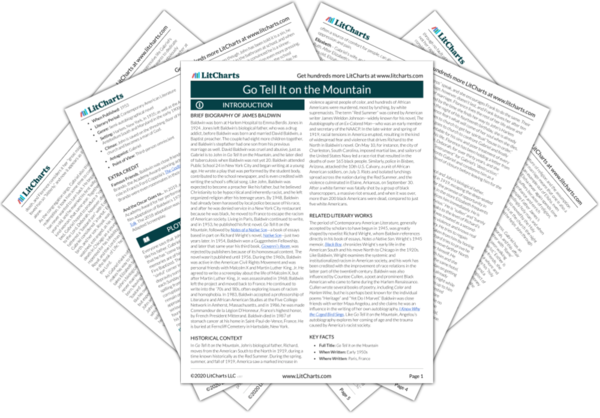Mountains are symbolic of the “narrow” and difficult way of the holy life in Go Tell It on the Mountain. Indeed, mountains are named directly in Baldwin’s title, and he repeatedly references them throughout the novel. The morning that Gabriel falls to his knees and is saved by the Lord, he is in “that valley where his mother [Rachel] had told him he would find himself,” beyond anyone’s help but God’s. Gabriel’s spiritual transformation occurs at the foot of a small mountain, at the top of which sits Rachel’s cabin, near a tree he passes each morning on his way home from nights spent with “harlots.” The tree marks the point “between sins committed and sins to be committed”—at the top of the mountain is the holy home of his mother, and at the bottom, past the tree, are the sins of whiskey and women. When Gabriel is saved that morning by the tree, the mountain symbolizes the uphill climb Gabriel has in resisting sin and remaining holy.
When John climbs the mountain in Central Park and looks down on the city Gabriel has warned him will only lead his soul to “perdition,” John stops at the “summit.” The people below bear the “marks of Satan,” and the movie houses “invite people to sin.” At the bottom of the mountain is sin and immorality, and at the top is righteousness. “If it’s wrong, I can always climb back up,” John thinks to himself as he runs down the mountain. Similarly, as Elizabeth repents and is saved after the birth of her “bastard son,” John, she begins an “upward climb—upward, with her baby, on the steep, steep side of the mountain.” As Gabriel says, the holy way “ain’t all in the sinning and the shouting—the way of holiness is a hard way,” and even after John himself is saved on the threshing-floor of their Harlem church, Gabriel claims John still “got the steep side of the mountain to climb.” Being saved by God is no simple task, the story suggests, and remaining saved is just as difficult. The “narrow way” of “eternal life” is littered with sin and temptation, and mountains signify the trials of resisting this temptation.
Mountains Quotes in Go Tell It on the Mountain
To sweep the front room meant, principally, to sweep the heavy red and green and purple Oriental-style carpet that had once been that room’s glory, but was now so faded that it was all one swimming color, and so frayed in places that it tangled with the broom. John hated sweeping this carpet, for dust rose, clogging his nose and sticking to his sweaty skin, and he felt that should he sweep it forever, the clouds of dust would not diminish, the rug would not be clean. It became in his imagination his impossible, lifelong task, his hard trial, like that of a man he had read about somewhere, whose curse it was to push a boulder up a steep hill, only to have the giant who guarded the hill roll the boulder down again—and so on, forever, throughout eternity; he was still out there, that hapless man, somewhere at the other end of the earth, pushing his boulder up the hill.
Richard said that they would marry as soon as he had saved some money. But since he was going to school at night and made very little money, their marriage, which she had thought of as taking place almost as soon as she arrived, was planned for a future that grew ever more remote. And this presented her with a problem that she had refused, at home in Maryland, to think about, but from which, now, she could not escape: the problem of their life together. […] She had kept, precariously enough, what her aunt referred to as her pearl without price while she had been with Richard down home. This, which she had taken as witness to her own feminine moral strength, had been due to nothing more, it now developed, than her great fear of her aunt, and the lack, in that small town, of opportunity. Here, in this great city where no one cared, where people might live in the same building for years and never speak to one another, she found herself, when Richard took her in his arms, on the edge of a steep place: and down she rushed, on the descent uncaring, into the dreadful sea.












